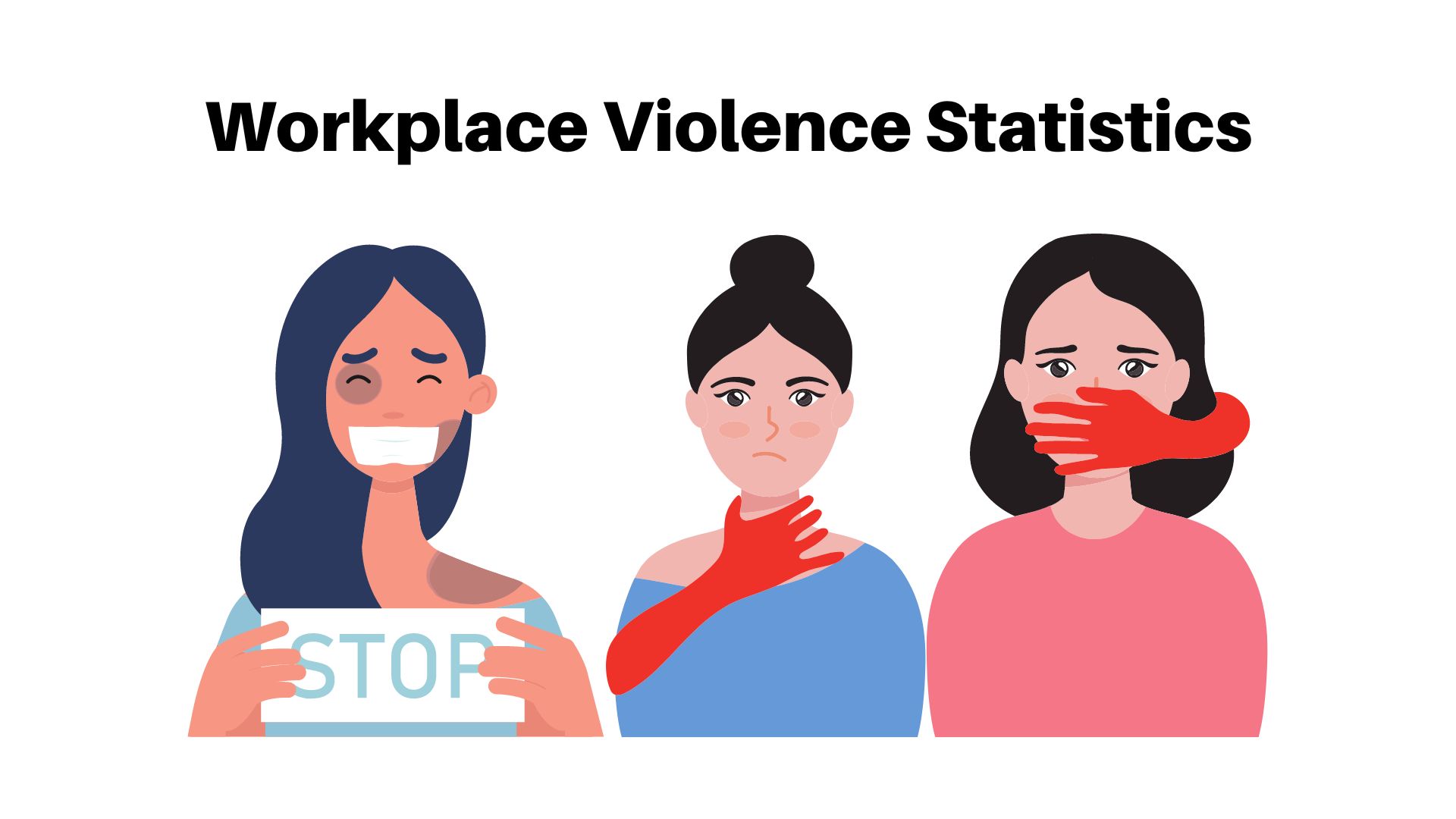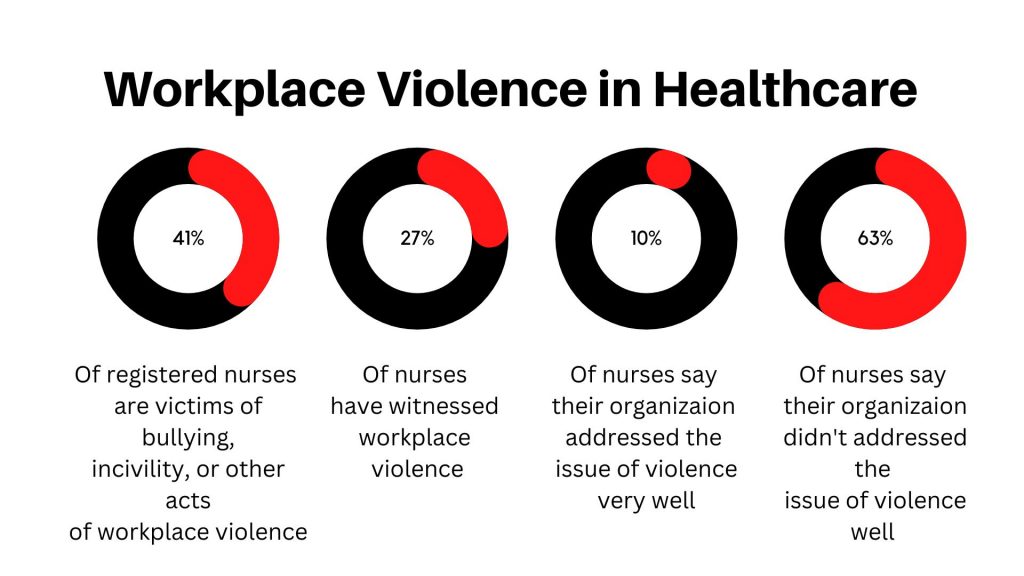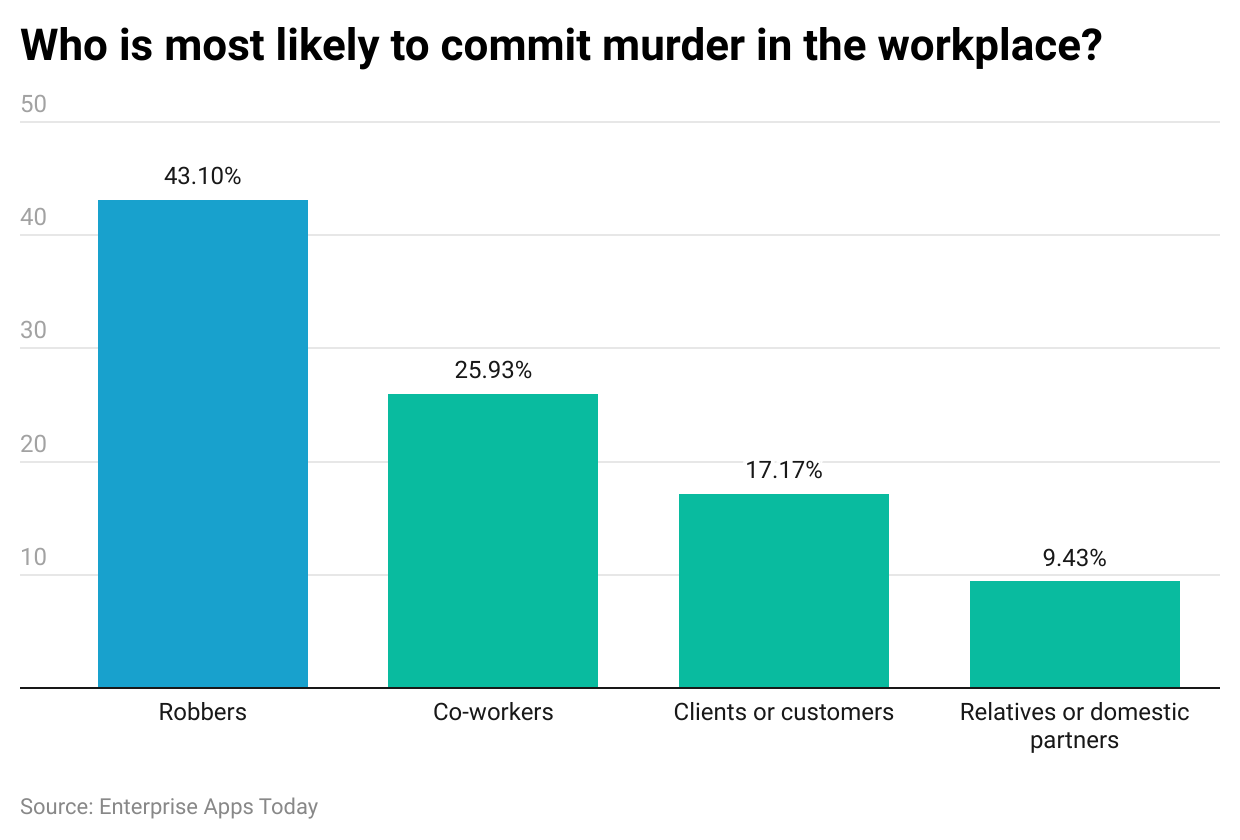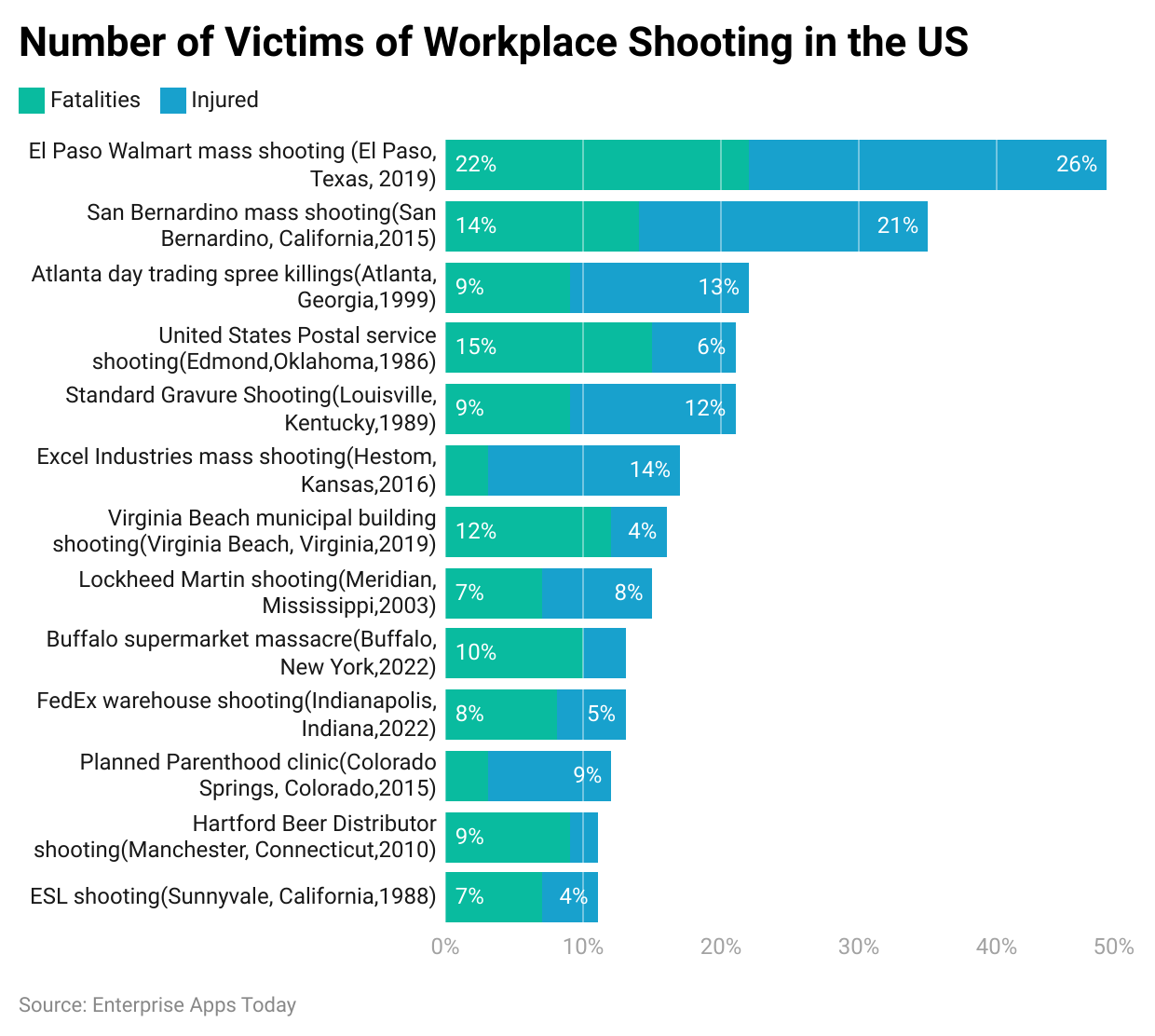30+ Shocking Workplace Violence Statistics In 2023

Page Contents
Workplace Violence Statistics: Workplace violence statistics give you a better understanding of the threats in particular work environments. In addition, the information you are about to read will demonstrate how frequently violent crimes against workers occur in various sectors of the economy.
We have also addressed the statistics on mass workplace shootings, which are frequent in the United States. However, you can gain more information about workplace accidents around the world by looking at the global facts and statistics about workplace violence.
If you are interested in learning more about workplace violence statistics, let's look at the helpful data we have gathered.
Workplace Violence Statistics (Editor's Choice)
- 45% of employees in the United States are aware that their employers have workplace violence prevention initiatives in place as of January 2022.
- Nearly 41% of registered nurses have experienced incivility, bullying, or other forms of workplace violence.
- 28% of workers know about workplace violence incidents within their companies.
- Businesses suffer annual losses of $250–330 billion due to workplace violence.
- Hospitals lose $53.7 million a year due to attacks on medical personnel.
- According to workplace violence stats, nearly 251 fatal work-related injuries happen because of violence.
- More than 30% of nurses reported increased attacks against them as of Q4 of 2021.
- Kicking, hitting, pushing, or beating have been the cause of 7.7% of workplace fatalities.
- Approximately 47% of ER doctors report a physical assault.
- Approximately 4.7% of neurosurgeons have experienced at least one physical assault at the workplace in the entire country.
- Around 23.3% of workers claim they have been bullied through email.
- Approximately 44% of school teachers report workplace attacks.
- The Oklahoma postal service massacre in 1986 was the second most deadly workplace shooting by a total number of victims in United States history.
- According to the most recent stats, nearly 56,034 officers have been attacked at the workplace.
- In Wales and England, approximately 307,000 adults report experiencing violence at the workplace.
- 43% of women in Taiwan report being sexually harassed at work.
- In 2023, the United States of America observed 13 workplace shootings out of which 8 were injured and 5 experienced fatalities.
- 85% of the death ratio in workplace violence has been caused by robbery in the United States of America.
- Every year, in the United States of America, 400,000 aggravated assaults take place in the workplace.
- 68% of employees do not feel safe at their workplaces.
- Every year in the United States of America, 2 million employees are injured because of various reasons including intentional violence, handling, lifting, and carrying accidents, slips, trips, falls, and being struck or caught in machinery.
General Workplace Violence Statistics
#1. 45% of employees in the United States are aware that their employers have workplace violence prevention initiatives in place as of January 2022.
According to statistics on workplace violence for 2022, more than half of all US workers are unaware of their employer's safety plan or violence prevention. Due to the ambiguity of workplace violence policies, up to 24% of employees claim they are unsure if they even exist. These policies cover things like shootings, fire emergencies, and medical emergencies.
(Source: SHRM, Zippia)
#2. Nearly 41% of registered nurses have experienced incivility, bullying, or other forms of workplace violence.
An analysis shows the safety issues nurses face every day across the country. While 27% of nurses have been victims of workplace violence, 10% of nurses believe their organization has addressed the problem well. Unfortunately, 63% of the nurses claim that the organization did not respond well.
(Source: AMN Healthcare)

#3. 28% of workers know about workplace violence incidents within their companies.
More than one-fourth of the workers polled know that occupational violence happens in the workplace. Around 20% of workers claim to have seen workplace violence between colleagues, and 8% claim to have engaged in hostile interactions. Additionally, 19% of workers are unsure if workplace violence exists among their coworkers.
(Source: SHRM)
#4. The number of sexual assaults at work that women report each year is 30,000.
Tragically, there is nothing new about violence against women.
Most females endure attacks while working, too, from offensive comments to straight-up rape. Also, remember that the number of reported attacks is 30, 000. We do not even want to guess how many cases go undetected.
The best solution is to run a background check on your coworkers to prevent similar instances. You shouldn't mingle with sexual predators.
There is more, though.
According to statistics on workplace sexual assault, the coronavirus seems to be making most things worse.
(Source: What to Become)
#5. Businesses suffer annual losses of $250–330 billion due to workplace violence.
One research shows that work-related violence is a significant problem for millions of employees in the United States. Sadly, around 25% of workers remain silent about the issue. This results in employees failing to address this issue. Their businesses suffer significant losses due to absenteeism, lawsuits, injuries, and decreased productivity. Furthermore, a damaged reputation also results in a decline in clients.
(Source: Forbes)
#6. Hospitals lose $53.7 million a year due to attacks on medical personnel.
According to statistics on workplace violence in the healthcare industry, doctors spend around 112.8 hours away from the hospital due to violence committed on the job. The employees who must cover shifts and deal with hostile patients get more stressed.
As a result, healthcare employees experience significant job dissatisfaction, burnout, depression, and yearly losses of $53.7 million.
(Source: 911Celluar)
#7. According to workplace violence stats, nearly 251 fatal work-related injuries happen because of violence.
The information comes from a recent poll of adults 55 and older. In addition, workplace violence by humans or animals is the 4th most typical reason for fatal work injuries in this age group.
(Source: US Bureau of Labor Statistics)
#8. More than 30% of nurses reported increased attacks against them as of Q4 of 2021.
These statistics on nursing injuries are somewhat alarming. They show that as of September 2021, the main reason for the rise in violence against nurses was tight politics around vaccines. According to 31% of nurses—up from 22% in March 2021—patients are more violent toward nurses due to their close contact and the prolonged time they spend together.
(Source: Business Insider)
#9. According to workplace violence stats, female employees are 5 times more likely to be slain by a family member or domestic partner within the workplace than men employees.
The 3rd most common reason for job fatalities is workplace violence. According to studies, homicide accounts for 35% of deaths of women at work. However, females are more at risk than males.
(Source: AFL-CIO, JRank)
#10. Each year, nearly 1.5 million workplace attacks are reported.
According to national statistics, many workplace violence incidents are not reported. Of the total, 396,000 are aggravated assaults. 51,000 of those are sexual assaults or rapes. Annually, there are approximately 84,000 robberies as well as 1,000 homicides.
(Source: The Balance Careers)
#11. Around 20% of nurses are dealing with increased violence in the workplace.
These findings come from a recent survey of 15,000 registered nurses across the country. The nurses reported a higher level of violence within the workplace during the COVID-19 pandemic, and they stated most of the verbal and physical violence came from patients.
(Source: Healthcare Finance News)
#12. One in seven workers expresses a lack of safety at work.
Can you imagine going to work and being afraid to arrive at the office?
Even I am unable.
But for some people, that is the truth. And as you would have guessed, being anxious a lot results in being less productive.
(Source: Legal Jobs)
#13. Head injuries occur in 35% of workplace violence events.
Although attackers frequently target the head, statistics on workplace violence also demonstrate that:
- 14% had an impact on the trunk.
- 7% were targeted at the lower body.
- Upper body injuries account for 21% of all injuries.
(Source: Legal Jobs)
#14. Approximately 47% of ER doctors report a physical assault.
The ER is one of the most frequent healthcare workplaces experiencing violence. Out of 3,500 ER doctors, nearly 97% claim that patients are the primary source of assault. Additionally, patients threatened to harm 83% of doctors.
(Source: Marketing General Incorporated)
#15. Nearly 43.10% of homicides happen in the workplace during robberies.
According to research, robbers are most likely to commit workplace homicide. Additionally, coworkers come in second with roughly 25.93%, and consumers come in third with nearly 17.17%. Finally, about 9.43% of incidents of workplace violence are caused by family members or domestic partners.
(Source: Zippia)

(https://whattobecome.com/blog/workplace-violence-statistics/)
#16. Kicking, hitting, pushing, or beating have been the cause of 7.7% of workplace fatalities.
Patients aren't the only ones. Many workers experience workplace assault by a superior or colleagues.
Physical assault at work can take many forms, including pushing, kicking, hitting, and beating.
Verbal assaults are only involved in just 2% of cases.
(Source: Legal Jobs)
#17. Approximately 4.7% of neurosurgeons have experienced at least one physical assault at the workplace in the entire country.
According to workplace violence in the healthcare industry stats, this kind of violence is very common in many medical specialties. Neurosurgery is just one example. Furthermore, almost 53.3% of the respondents said they had experienced it. Nearly 17.8% of neurosurgeons also obtained weapons because of patient threats.
(Source: PubMed)
#18. 70% of assaulted hospital staff members are not injured.
Cal/OSHA reports that violence against health employees continues despite the hospital safety act. Statistics on workplace violence in hospitals indicate that 16,177 instances in the healthcare industry do not result in any injuries. 20% of cases involve cuts and bruises. Other injuries include head injuries, psychological problems, fractures, burns, etc.
(Source: NBC Bay Area)
#19. Around 23.3% of workers claim they have been bullied through email.
Statistics on workplace bullying suggest that approximately 20.2% of people have been embarrassed due to rumors.
17.8% have experienced yelling.
These are only the most recent issues. We will never know how many remain unseen.
Sometimes, things can even become physically violent.
(Source: Admissions)
Statistics on Workplace Shootings
#20. In more than a year, the bloodiest workplace massacre happened at the FedEx Indiana warehouse.
According to workplace violence stats, the number of shootings at work is increasing in the United States. Five individuals lost their lives in the second-deadliest shooting, which happened earlier that year at the Molson Coors Headquarters, in Milwaukee. In the 2020 shooting at the FedEx warehouse, eight people died.
(Source; NBC News)
#21. Approximately 44% of school teachers report workplace attacks.
Unfortunately, school shootings are not that uncommon, especially in the USA.
However, we're discussing all forms of violence here, including sexual, verbal, and physical. The worst thing is that, according to statistics on workplace violence, teachers frequently choose not to report those incidents in order to protect their students.
(Source: What to Become)
#22. Nearly 22,088 law enforcement personnel have been assaulted by guns between 2010 and 2019.
9.2% of victims were injured in these assaults. In addition, the number of casualties was highest in 2017, out of 2,677 officers being shot while on duty; nearly 10.2% of officers were injured.
(Source: UCR FBI)
#23. The Oklahoma postal service shooting in 1986 is the second-deadliest workplace shooting by a total number of victims in US History.
It is also the country's third-largest mass killing in the workplace, with 15 deaths and 6 injuries.
Disgruntled workers are often responsible for mass shootings at work. Additionally, people with mental health issues committed several of the bloodiest workplace shooting incidents.
(Source: Statista, Oklahoma Historical Society)

(https://whattobecome.com/blog/workplace-violence-statistics/)
Workplace Violence Statistics by Industry
#24. According to workplace violence stats, approximately 45% of retail deaths are due to injury and violence from people and animals.
In 2019, 16 out of 36 retail-sector-related fatalities were caused by people or animals. The retail sector also has the highest rate of workplace violence victimization. According to OSHA, employees in gas stations, jewelry, liquor, and grocery stores are more likely to experience workplace violence.
(Source: US Bureau of Labor Statistics, AmTrust Financial)
#25. Taxi drivers are roughly 20 times as likely to be killed on the job as compared to other professionals.
According to workplace violence stats in several sectors, taxi drivers are a high-risk group. Taxi drivers are more likely to experience workplace violence if they carry cash, work night shifts, and transport intoxicated passengers.
(Source: OSHA)
#26. According to the most recent stats, nearly 56,034 officers have been attacked at the workplace.
According to the latest FBI LEOKA report, out of the overall number of assaulted officers, around 17,188 of the officers who were attacked suffered injuries. In addition, approximately 79.3% were assaulted with personal weapons and roughly 3.8% with firearms. In 1.9% of the incidents, attackers employed knives and other cutting tools.
(Source: UCR FBI)
#27. Client, patient, or visitor is the most common workplace violence in the healthcare sector.
73% of all workplace violence victims are healthcare professionals. The people that hurt them the most frequently are patients. The most common places for patient/staff violence are waiting rooms, emergency rooms, geriatric settings, and psychiatric facilities. Additionally, patients' visitors and family members also often commit crimes.
(Source: Nursing World. US Bureau of Labor Statistics)
#28. Approximately 70-74% of assaults within the workplace happen to social professionals.
Social professionals have a nearly five-fold increased risk of workplace injuries due to the nature of their work. Social workers assist mentally ill persons addicted to drugs and alcohol and with a history of violence. In addition, there is a higher possibility of assault when people visit homes in high-crime areas.
(Source: EHS Daily Advisor Social Workers)
Global Workplace Violence Statistics
#29. 61.6% of freelancers in Japan report experiencing power-related harassment in their workplace.
According to an online survey, the majority of freelancers in Japan have experienced workplace harassment. Only 36.6% reported workplace sexual harassment, and around 45% of all employees chose not to inform anybody about the incidents.
(Source: Statista)
#30. In Wales and England, approximately 307,000 adults report experiencing violence at the workplace.
According to the same survey, 668,000 workers reported workplace violence incidents. Nearly 38% of these cases result in injury, with the majority of cases being bruising.
(Source: Health and Safety Executive)
#31. 43% of women in Taiwan report being sexually harassed at work.
According to statistics on workplace violence, many Taiwanese female workers are victims of some type of sexual harassment. However, workplace sexual harassment statistics indicate that most females are reluctant to report it. Therefore, there may be more casualties overall.
(Source: Statista)
#32. According to workplace violence stats, protective service occupations in Wales & England have around 8.4% risk of violence at work.
All occupations in Wales & England have a risk of 1.4% of experiencing violence at work. Additionally, a crime survey reveals that workers in the protective services face greater risk; they are six-fold more likely to be attacked and threatened than the average.
(Source: Health and Safety Executive)
#33. In Italy, 58% of teachers have experienced workplace violence.
According to the most recent data, more than half of teachers experience physical violence at work. In 80% of cases, the perpetrator is men. Parents attack teachers (20%) and students (57%). Furthermore, 14% of instructors consider leaving the profession due to the abusive behavior they encounter. But just 12% of people have changed it.
(Source: MDPI)
Conclusion
These workplace violence figures are simply terrifying.
The saddest aspect is that numbers keep increasing while businesses are woefully unprepared to deal with such situations.
Workplace violence is a persistent problem, and studies suggest that some professions are more likely to experience it. They also demonstrate that no profession is safe from violence. Additionally, workplace violence comes in many forms and affects both male and female employees at all levels and across all industries worldwide.
Therefore, businesses must take precautions to keep their staff members safe. While prevention programs can be helpful, increased security measures can also be beneficial. Furthermore, background check organizations provide valuable information about potential employees, and mental health screenings can quickly identify any mental disorders in employees.
Be careful when you're outside!
Sources
FAQ.
negatively affects employees in various ways. Some of the most frequent ones are decreased productivity, increased absences from work, lower work satisfaction, and health issues. Workers may develop the post-traumatic disorder in more severe cases.
Other individuals may feel depressed, stressed, anxious, or isolated. Many others also suffer from physical injuries. Workplace violence can also have a profound impact on victims' personal lives. According to statistics on workplace violence, these people's relationships with their families, relatives, and romantic partners are affected due to violence.
Numerous studies have shown that exposure to violence at work
Bullying and job stress are the two most frequent causes of violence in the workplace. Both can result in PTED, or post-traumatic embitterment disorder, a psychological illness. People often experience this disorder as a result of a traumatic event at work.
They frequently become angry employees who engage in various violent activities at work, which is a frequent result of general employer negligence. Fear, anger, and depression are common emotions with this condition. They regrettably also have the potential to incite violent behavior in those who have serious mental health issues.
Many factors increase the likelihood of workplace violence. According to studies, workers who carry or exchange money with the public while at work frequently become the targets of violence. Working with unstable individuals can also be dangerous. Working in isolated areas or on night shifts increases the risk of violent behavior.
A further risk factor is residing in high-crime zones. Addiction to alcohol and drugs, stress, and a lack of background checks before hiring all have harmful effects. Workers may react negatively to layoffs, poor management, and another restructuring.
Unfortunately, many employees do not report violence at work. Therefore, we are unable to estimate the exact number of cases. However, the Bureau of Justice Statistics indicates that every year in the United States, nearly 1.5 million people experience workplace violence. This is less than 1% of the US total population.
Violence at work happens everywhere across the globe. For instance, 15% of all Canadian employees report experiencing a violent assault at work. Furthermore, the rates of workplace violence are high in the Netherlands, Finland, the United Kingdom, and Europe. 25% of Indian workers have reported being physically assaulted at work.

Barry is a lover of everything technology. Figuring out how the software works and creating content to shed more light on the value it offers users is his favorite pastime. When not evaluating apps or programs, he's busy trying out new healthy recipes, doing yoga, meditating, or taking nature walks with his little one.



